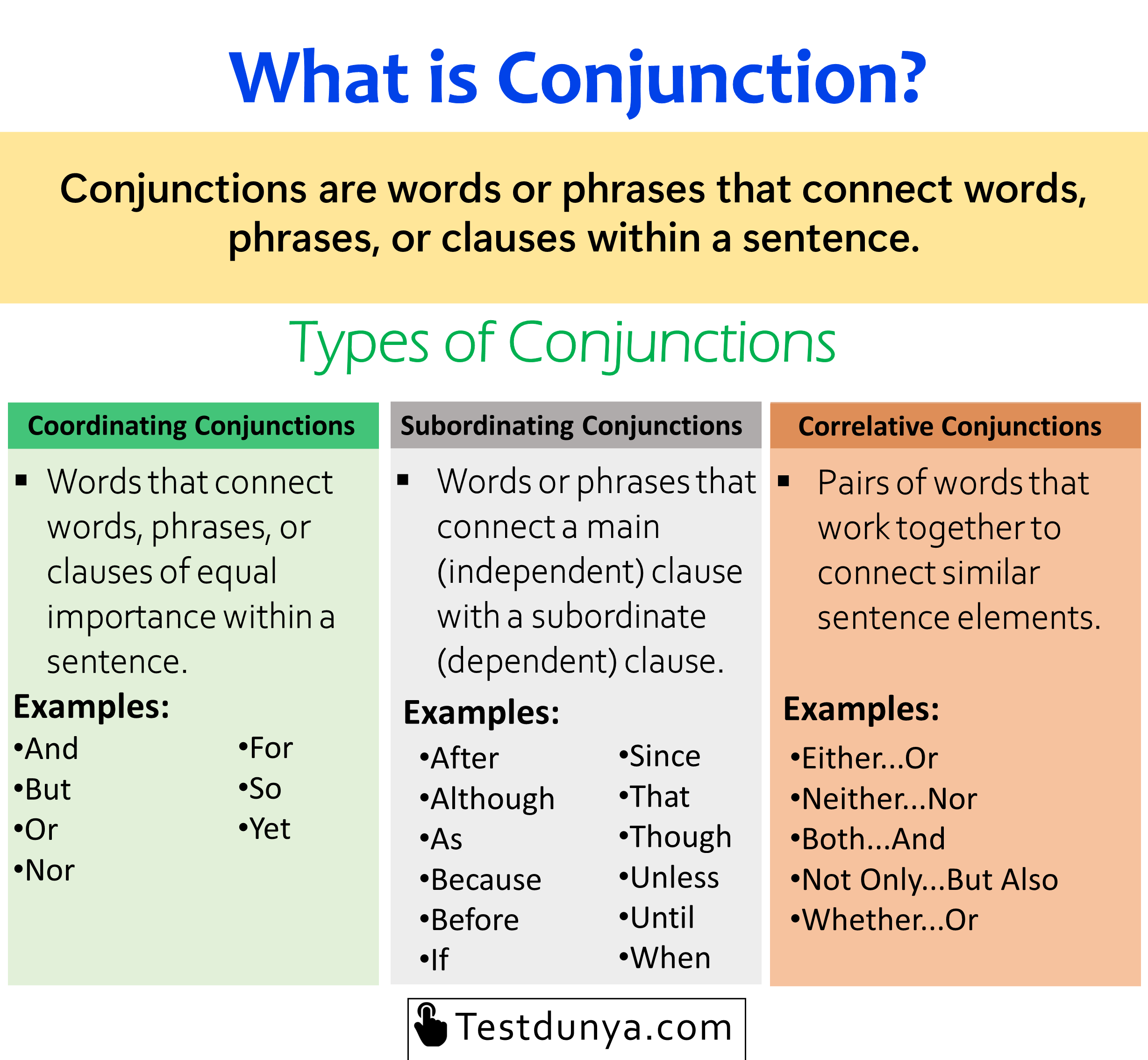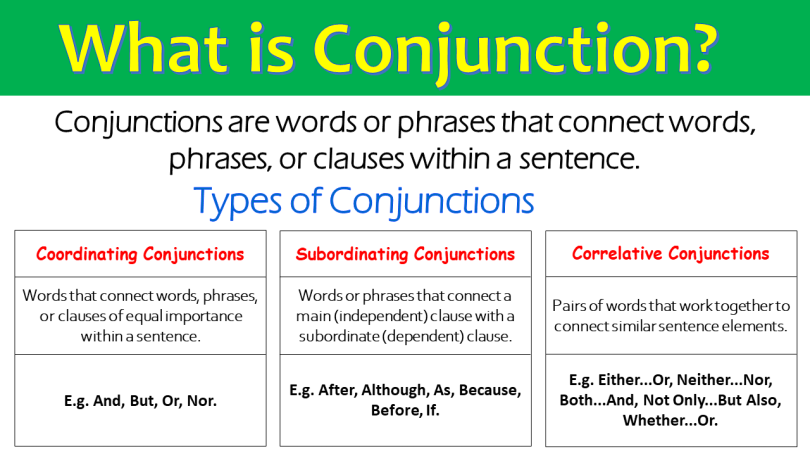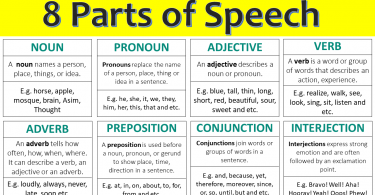Conjunctions are words or phrases that connect words, phrases, or clauses within a sentence. They are important in English grammar because they help establish relationships between different parts of a sentence, making the meaning clear and the structure cohesive. Conjunctions allow us to join words or phrases together, creating longer and more descriptive sentences. They enable us to express ideas, thoughts, and actions in a connected and coherent manner. Conjunctions help convey relationships between different parts of a sentence. They can indicate addition, contrast, cause and effect, condition, time, or purpose. By using conjunctions, we can express how one idea relates to another, making our communication more precise.
Here is a list of commonly used conjunctions:
- and
- but
- or
- nor
- for
- so
- yet
- after
- although
- as
- because
- before
- if
- since
- that
- though
- unless
- until
- when
- where
- while
- either…or
- neither…nor
- both…and
- not only…but also
- whether…or
- however
- therefore
- moreover
- nevertheless
- consequently
- meantime
- furthermore
- otherwise
- similarly
- where
- wherever
- when
- whenever
This list includes some of the most commonly used conjunctions in English. However, there are additional conjunctions that are less frequently used or have more specific functions.

Types of Conjunctions with Examples
Types of Conjunctions
- Coordinating Conjunctions: Coordinating conjunctions are words that connect words, phrases, or clauses of equal importance within a sentence. They are used to join similar or related elements. Here are some coordinating conjunctions along with examples:
- “And”: Adds information or combines similar ideas.
Example: I like to read books, and I enjoy watching movies.
- “But”: Shows contrast or contradiction between two ideas.
Example: She wanted to go out, but it started raining.
- “Or”: Presents a choice or alternative between two options.
Example: Would you like tea or coffee?
- “Nor”: Adds another negative idea or option to a previous negative statement.
Example: He doesn’t like spinach, nor does he eat broccoli.
- “For”: Gives a reason or explains a cause.
Example: She worked hard, for she wanted to succeed.
- “So”: Indicates a result or consequence.
Example: The weather was hot, so we decided to go swimming.
- “Yet”: Shows contrast or introduces an unexpected result.
Example: She studied hard, yet she didn’t perform well in the exam.
- Subordinating Conjunctions:
Subordinating conjunctions are words or phrases that connect a main (independent) clause with a subordinate (dependent) clause. The subordinate clause relies on the main clause for its meaning and cannot stand alone as a complete sentence. Here are some subordinating conjunctions along with examples:
- “After”: Indicates time or sequence.
Example: After she finished her work, she went for a walk.
- “Before”: Specifies a time or event that precedes another.
Example: I want to eat dinner before watching a movie.
- “Because”: Introduces a reason or cause.
Example: She couldn’t attend the party because she was feeling unwell.
- “If”: Expresses a condition or possibility.
Example: If it rains, we will stay indoors.
- “Since”: Indicates a cause or reason, similar to “because”.
Example: Since it’s a holiday, we can go for a trip.
- “Although”: Introduces a contrast or concession.
Example: Although it was late, she continued studying.
- “While”: Specifies a simultaneous action or event.
Example: She listened to music while doing her homework.
- Correlative Conjunctions:
Correlative conjunctions are pairs of words that work together to connect similar sentence elements. These conjunctions are used to join two equal grammatical items within a sentence. Here are some examples of correlative conjunctions along with their usage:
-
- “Either…or”: Indicates a choice between two options.
Example: You can either go to the party or stay at home.
-
- “Neither…nor”: Presents a negative choice between two options.
Example: Neither the cat nor the dog wants to go outside.
-
- “Both…and”: Indicates the inclusion or combination of two elements.
Example: She is both smart and kind.
-
- “Not only…but also”: Highlights two elements, emphasizing their joint significance.
Example: He is not only intelligent but also hardworking.
-
- “Whether…or”: Introduces alternatives or possibilities.
Example: I don’t know whether he will come or not.
-
- “As…as”: Shows an equal degree or comparison between two things.
Example: John is as tall as his brother.
- Conjunctive Adverbs:
Conjunctive adverbs are adverbs that function as conjunctions. They connect two independent clauses (complete thoughts) or provide transitions within a sentence. Conjunctive adverbs help to indicate relationships such as cause and effect, contrast, sequence, or time. Here are some examples of conjunctive adverbs along with their usage:
- “However”: Indicates contrast or introduces a different perspective.
Example: She studied hard; however, she didn’t perform well on the test.
- “Therefore”: Shows a cause-and-effect relationship or a conclusion.
Example: He studied diligently; therefore, he passed the exam with flying colors.
- “Moreover”: Adds information or provides an additional point.
Example: The hotel has a great location. Moreover, it offers excellent amenities.
- “Nevertheless”: Shows contrast or introduces a counterpoint.
Example: It was raining heavily; nevertheless, we decided to go for a walk.
- “Meanwhile”: Indicates events happening at the same time or in parallel.
Example: She was cooking dinner. Meanwhile, he was setting the table.
- “Consequently”: Shows a cause-and-effect relationship or a result.
Example: She overslept; consequently, she missed her bus.
- “Additionally”: Adds information or provides an extra detail.
Example: The project was completed on time. Additionally, it received positive feedback.
- Subordinating Conjunctions of Place and Time:
Subordinating conjunctions of place and time are specific types of subordinating conjunctions that indicate the location or time of an event in relation to the main clause. They introduce subordinate clauses that provide additional information about where or when something happened. Here are some subordinating conjunctions of place and time along with examples:
- “Where”: Indicates the location of an event or action.
Example: I visited the park where we used to play as children.
- “Wherever”: Refers to any location, no matter where.
Example: You can sit wherever you like in the classroom.
- “When”: Specifies the time at which an event occurs.
Example: I will call you when I arrive at the airport.
- “Whenever”: Refers to any time or every time.
Example: Whenever I hear that song, it brings back memories.
Subordinating conjunctions of place and time help provide context and specify the location or time associated with the main clause. They allow for more detailed descriptions and help establish a relationship between different parts of a sentence. By using these conjunctions, you can provide additional information about where or when an action took place.



